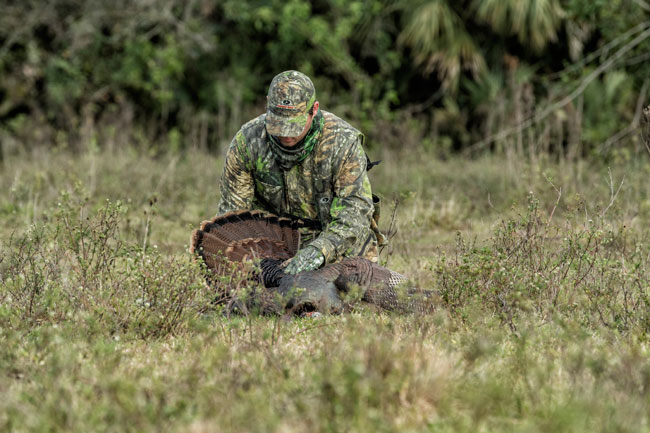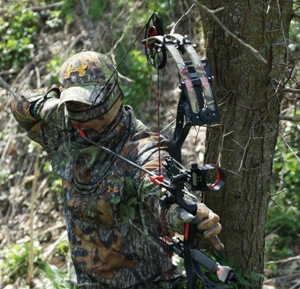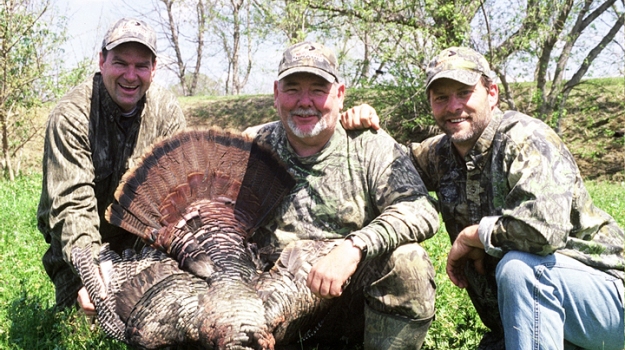by Brian Stephens

It is almost here! For those of you who are getting geared up for Spring Turkey season, read on. Turkey hunters are a passionate and dedicated group of sportsmen and women all across the United States. Getting a bead on a tom with a shotgun can be hard enough but when you decide to do it with your bow, that challenge becomes significantly higher.
While I am a hardcore bowhunter for whitetails, I am beyond passionate about turkey hunting. I place myself in that group that is borderline “freaky” about chasing birds. I have been fortunate to harvest a lot of birds during my hunting career. I am going to share some tips and lessons I have learned along the way. In this article I will answer three common questions regarding chasing turkeys with a bow and arrow:
- What is the best type of broadhead for bowhunting turkeys?
- Bowhunting setups: which is better? Blind or ground?
- What are some common calling mistakes new bowhunters make when turkey hunting?
What is the best type of broadhead for bowhunting turkeys? The one that flies straight. Seriously, like most anything else, broadhead choice is more a matter of preference and individual performance than anything else. With this being stated, my preference is mechanical. They fly like field tips and due to the “mechanical” expansion, they normally will stay within the turkey.
When shooting turkeys with broadheads, if they run or fly after the shot, they usually do not leave the best blood trails. The ideal shot is to accurately place an arrow that penetrates at least one wing, if not both, while hitting the vitals. This will ensure a quick kill and a bird that is unable to fly. I have not shot the Guillotine broadheads, but like most that will read this, I have seen the impressive videos. For now, I will stick to my trusty mechanicals.
This year I will continue to shoot the 100-grain Swhacker. I shot the Turkey Slam with a bow in 2011 and used Swhacker on every hunt. Again, to me the best broadhead is the one you can confidently shoot into a very small, vital area consistently time and time again. I promise, the last thing you want to be thinking about is arrow flight when that tom is out their spitting and drumming at 20 yards.
When hunting for turkeys with a bow, your setup is critical. I often get the question regarding which is better, hunting from a blind or from the ground? In my opinion, both are effective options. The real question is what type of “turkey chaser” are you and what is the situation.
Before I discuss the actual setup itself, if you are bowhunting turkeys for the first time, the first thing you will learn is truly how impressive the wild turkey is at picking up movement. I have killed a lot of turkeys with a shotgun, but it was not until I started toting a bow in the turkey woods that I really began to appreciate the eyesight of a turkey. The first spring I tried to hunt turkeys with a bow, I probably spooked no less than 8-10 gobblers within just a few weeks. It takes practice getting your setup right on a turkey with a bow. To me, it is different than with a gun. With a gun, you can find the smallest amount of cover and drop down and know that if that bird walks within 55 yards, it’s typically over. With a bow, I need them within 20-30 yards to feel confident on such a small target. Therefore, your setup is everything.
Blind or ground? It depends. I have used both. For me, if I know where a gobbler likes to hang out and strut and have the ability to setup a blind without him seeing me, then this is a great option. What is interesting about turkeys and blinds is, in my opinion, turkeys are more “forgiving” than whitetail deer in a quick set up scenario. I am the type of turkey hunter that likes to “run and gun.” Sitting for long periods in a ground blind is not my idea of fun. Every person is different, and for me, I enjoy walking the woods and trying to strike a “hot” bird.
Therefore, I prefer the ground setup mainly because of my style of turkey hunting. Again though, if I have a bird roosted and I know where he likes to strut, I would jump at the opportunity to be sitting in a blind at daylight in hopes he would come to my calling and decoys 15 yards in front of my blind.
Hunting from the ground, as I have already mentioned, is very difficult for many reasons. You need the bird to get within that 20-30 yard range, and you really cannot draw your bow until they do. This requires attention to detail on your camouflage, your setup, and your decision on when to actually draw. That is why I love the Mossy Oak Obsession pattern. It blends into the Spring woods better than any other pattern I have seen.
 Putting as many factors in my favor as I can, what I have found works best for me is to setup on my knees with my left shoulder facing towards the direction I think the bird is going to come (next to brush for good backdrop). I try to find a bush or tree that will allow me to have good visibility in front of me, but be completely blocked on my sides and back. If coming to full draw on a tom is not hard enough, add a few hens or a subordinate or two, and the challenge has just increased dramatically.
Putting as many factors in my favor as I can, what I have found works best for me is to setup on my knees with my left shoulder facing towards the direction I think the bird is going to come (next to brush for good backdrop). I try to find a bush or tree that will allow me to have good visibility in front of me, but be completely blocked on my sides and back. If coming to full draw on a tom is not hard enough, add a few hens or a subordinate or two, and the challenge has just increased dramatically.
Finding the right time to draw, as it is with hunting any animal with a bow, will be the toughest challenge when hunting without a blind. If you love bowhunting, you will love bowhunting for turkeys.
The most common mistake that bowhunters make is not being patient and learning the softer calls that are necessary to get that bird those final 10-20 yards. I will be the first to admit that I would put myself on the list of more aggressive callers. I cannot help it. I love the interaction. Something runs through my body every time I hear a bird respond to me calling. There is just something about hearing a tom gobble that keeps me coming back again and again. Now with this being stated, cuts, cackles, kee kees, excited yelps, they are all great and can really get a bird fired up in the right situation. But it is the soft clucks, purrs, and whines that will bring that bird in those last few critical yards that are needed with a bow.
There are obviously tons of books and articles that have been written on calling techniques, so I will not go into too much detail around understanding how hot your bird is and knowing when and how much to call. What I will say is hunting with a bow does require a turkey hunter to be more patient than your typical run and gun shotgun hunter, that is, me. It requires you to shut up and let the bird come and once spotted, coax him in with purrs, whines, and clucks.
Best of luck bowhunting turkeys this spring! I hope these tips will help you along the way.



























